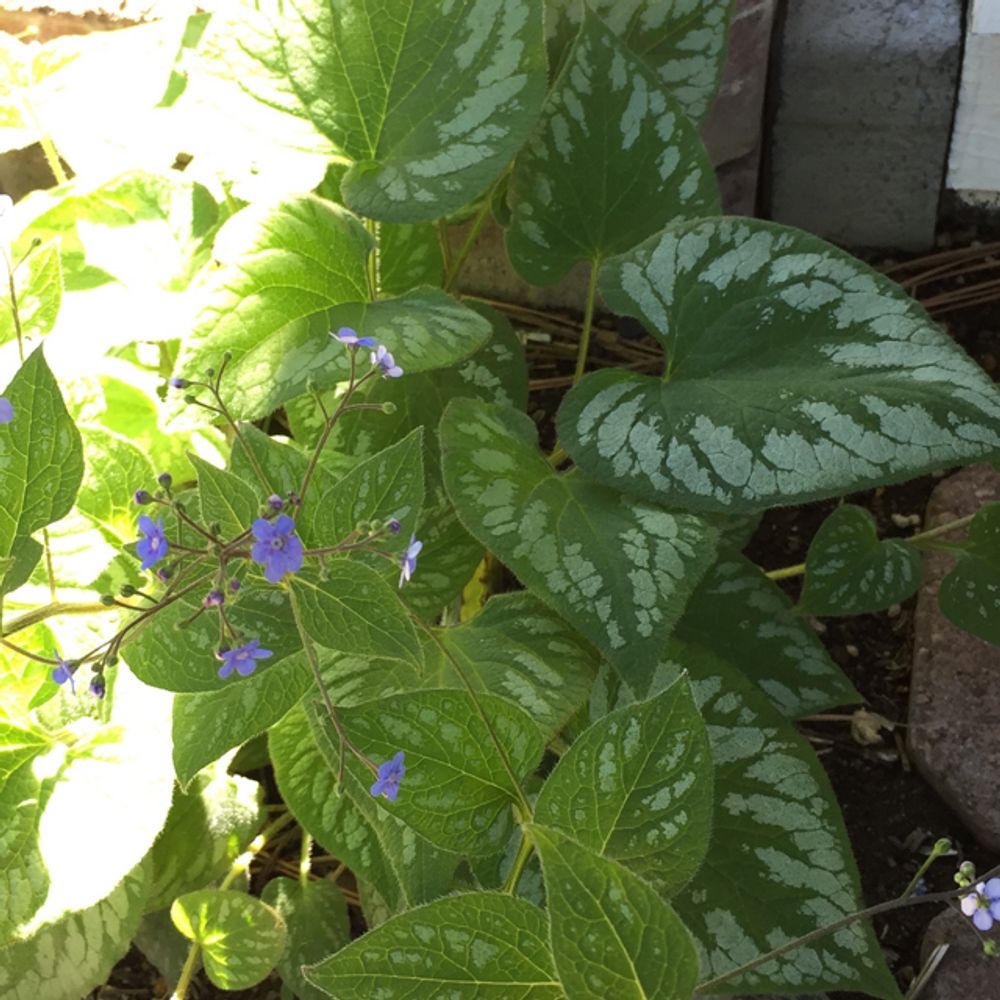Brunnera
(Brunnera)

Description
Brunnera macrophylla, commonly known as Siberian bugloss, large-leaved forget-me-not, or heart-leaved brunnera, is a herbaceous perennial plant that belongs to the Boraginaceae family. It is native to the mountainous regions of Siberia and the Caucasus, but has become a popular ornamental plant in gardens around the world. Description: Brunnera macrophylla grows to a height of 30-50 cm (12-20 inches) and has a spread of 45-60 cm (18-24 inches). It forms clumps of basal leaves that are heart-shaped, large (up to 20 cm in length), and have a rough texture. The leaves are a rich green color and have a silver-colored misting on the surface, which gives the plant a distinctive appearance. In the spring, Brunnera macrophylla produces spikes of blue, star-shaped flowers that rise above the leaves. The flowers are arranged in clusters and can be up to 20 cm (8 inches) long. The blooms last for several weeks and are very attractive to pollinators, such as bees and butterflies. Cultivation: Brunnera macrophylla is hardy in USDA zones 3-8 and prefers partial shade to full shade. It is best grown in moist, well-drained soil that is rich in organic matter. The plant is quite tolerant of a range of soil types, but does not do well in dry, barren soil. It is also tolerant of heavy clay soils if they are well-drained. Brunnera macrophylla is a slow-growing plant, but it can spread by underground stems (rhizomes) to form large clumps. The plant is best divided every three to four years to maintain its vigor and to prevent it from becoming too crowded. Uses: Brunnera macrophylla is an excellent plant for use in woodland gardens, shade gardens, and along the edges of ponds and streams. It is also an excellent choice for use as a groundcover in shady areas. The plant's silver-colored leaves provide a striking contrast to other green foliage plants and its blue flowers provide a pop of color in the spring. In addition to its ornamental uses, Brunnera macrophylla is also used as a medicinal plant in some cultures. The roots, leaves, and flowers of the plant have been used to treat a variety of ailments, including wounds, skin rashes, and digestive problems. Pests and Diseases: Brunnera macrophylla is generally pest and disease-free, but it can be susceptible to slugs and snails, which can damage the leaves. The plant is also susceptible to powdery mildew, which can cause the leaves to become covered in a white, powdery substance. Conclusion: Brunnera macrophylla is a beautiful and versatile perennial plant that is well-suited to gardens and landscapes. Its large, heart-shaped leaves and blue flowers make it a standout in the garden, and its ability to thrive in shady areas makes it an excellent choice for areas that receive little direct sunlight. Whether you are looking for a plant to use as a groundcover, or to add color and texture to your woodland or shade garden, Brunnera macrophylla is definitely worth considering. Brunnera Genus Brunnera is a genus of flowering plants in the family Boraginaceae. They are rhizomatous perennials, native to the woodlands of Eastern Europe and North West Asia. They have hairy leaves and sprays of blue flowers in spring. Numerous cultivars are available, which are valued as groundcover in dappled shade. Some possess variegated foliage. The best known species is Brunnera macrophylla, known as Siberian bugloss or 'Jack Frost.' It thrives in shade but also likes morning sunshine as long as it is in consistently moist, rich, organic soil. It does not tolerate dry conditions. It is often used in woodland gardens along streams of ponds and in naturalized areas as a specimen plant or clumped together as a border. Clumps slowly spread by both creeping rhizomes to form thick ground covers. 'Jack Frost's distinct silvery white leaves resemble frost on foliage.
Taxonomic tree:







